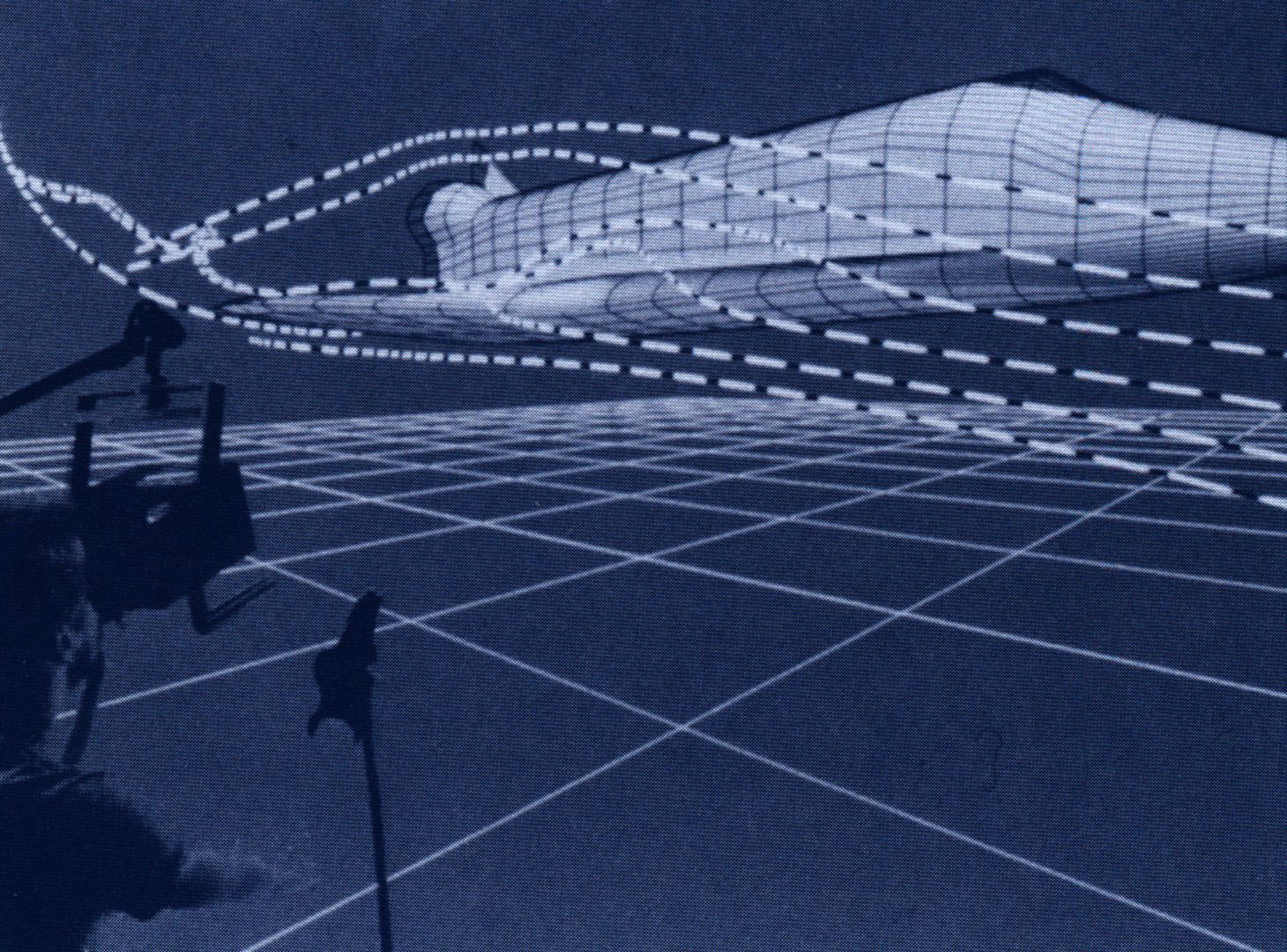“Be Here Now” by Bolas
Conference:
Experience Type(s):
Title:
- Be Here Now
Program Title:
- Demonstrations and Displays
Presenter(s):
Collaborator(s):
Project Affiliation:
- Fakespace Labs
Description:
Be Here Now combines a SiliconGraphics 340 VGX IRIS worksta-tion, a Polhemus 3Space digitizer, and a Fake Space Labs BOOM2 viewer to create three different virtual environments.
Fake Space Labs strives to build real tools for virtual worlds. “The Virtual Windtunnel” is an excellent example of a highly practical virtual environment system being used to do real science in an everyday setting. However, the only way to learn about and take advantage of the powers and abilities of virtual reality systems is to explore those systems as artistic media in their own right. “Tape World” and “Flatlands” are two such explorations.
“The Virtual Windtunnel”
Inside a simplified version of the NASA Ames Virtual Windtunnel, users explore numerically simulated airflow past a simplified model of the space shuttle orbiter landing at a five-degree angle of attack. A small cross-shaped cursor tracks the user’s hand position while a streamline is computed in real time starting at the user’s hand position. This gives users the feeling that they are releasing smoke into the virtual flow field from their fingertips. Users can then walk around inside the flow field and investigate vortices, separation, and other airflow phenomena.
The flow field was calculated offline on a Cray supercomputer and downloaded into the IRIS worksta-tion. Although this allows users to interact with the flow field, the shuttle model cannot be given a new orientation with respect to the free stream without a new flow field calculation. In the actual prototype system in use at NASAAmes, users are not constrained to a single-flow visualization tool. For example, a “rake” of streamlines extended between the fingers can be used to visualize airflow phenomena more intuitively.
“Tape World”
This experiment in virtual worlds designed by algorithm generates a slowly rotating semi-static mobile of curlicues, cracks, and fractal dust. As each user enters the system, the computer generates a unique custom world for exploration. No two worlds are alike.
Ribbons are generated with user-specified width, curvature, torsion, length, and behavior. Brownian noise is used to create trails of powder and wiry crumpled balls of string. The end result can be compared to being inside a biological macromolecule or exploring a box stuffed with present wrappings and stuffing. The world can be explored from different angles by walking around it with the viewer or lying down on the floor.
“Flatlands”
Piet Mondrian said that a painter should never try to imitate the three-dimensional world on a two-dimensional canvas. It seems ironic then, that when the empowering tools of a virtual environment system are available, we limit ourselves to trying to emulate our lowly three-dimensional world.”Flatlands” consists of the same set of elemental lines found in the Mondrian painting “Composition with Line” (1917). These lines are transformed through the illusion of perspective to create a three-dimensional jumble which coalesces into the original painting when the participant locates a specific point of view. The experience interplays two essential characteristics of the virtual environment medium: the ability to disregard physical laws and concentrate solely on form, and the recognition of and respect for the user’s continuous ability and desire to choose new points of view.
To make sure that you experience all three virtual worlds, please check the posted schedule for demonstration times.
System
The 4D/340 VGX IRIS, a multi-processor, RISC-based workstation with specialized graphics hardware, renders images of moderate complexity at up to 700,000 lit polygons per second. This high-level graphics power allows generation of head-coupled stereoscopic images with reasonable frame rates and without significant lag. Two factors vital to successfully engaging a user in a virtual environment.
Connected to the VGX through a standard RS232 serial data interface are the Polhemus tracker and the Fake Space Labs’ BOOM2 viewer. The Polhemus tracker generates a low frequency magnetic field through which its sensor is passed and derives a relative position and orientation between the magnetic source and the sensor.This gives the Polhemus an almost magical quality. It is able to track in three dimensions completely without constraints on the motion or path of its sensor within its working envelope. However, its full accuracy range is limited to 30 inches from the source, and it cannot be used with full accuracy near metal objects or magnetic devices. It also induces some lag while calculating the position and orientation of its sensor.
Most head-mounted systems use low-resolution LCD displays because they are unable to support the weight of high-resolution CRT monitors. The BOOM2’s mechanical linkage comfortably supports CRTs that produce monochrome images with over seven times the resolution of typical LCD-based head-mounted viewers. This level of resolution is essential for real-life applications where data must be accurately visualized.
In addition to its resolution and tracking advantages, the BOOM2 is well suited to applications that require the user to quickly enter and exit virtual worlds. For exam-ple, researchers do not have to”suit up” every time they turn from their terminals to look at a 3D world. And in design meetings, the BOOM2 viewer can be easily passed from one user to another, allowing them to share a common viewpoint from a single viewing device.
Other Information:
Application: Visualization, entertainment
Type of System: Authoring and player, single-user
Interaction Class: Immersive, inclusive
Acknowledgements:
Thanks to Silicon Graphics Computer Systems for the generous donation of a 4D/340 VGX for use at SIGGRAPH ’91; Creon Levit, Steve Bryson, and the NAS facility at the NASA Ames Research Center; Phil Stone, Jim Humphries, and Rick Jacoby of Sterling Software; Sally Rosenthal of Digital Equipment Corporation; Scott Fisher of Telepresence Re-search: Beth Wenzel of NASA Ames; Mark Bolas, Ian McDowall Russell Mead, Tim Parker, and Nanci Anderson of Fake Space Labs.





